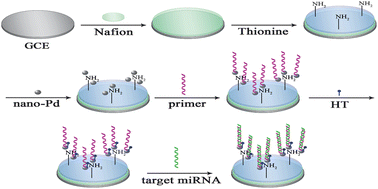
Schematic steps for biosensor detecting mRNAs
Short non-coding single stranded nucleotides known as microRNA (miRNA) have become important biomarkers due to their up- and down-regulated expression in certain cancers.
Jing Han and colleagues at Southwest University, China, targeted miRNAs using an electrochemical-based biological sensor containing palladium nanoparticles. A multilayer film coated the glass electrodes in order to bind the palladium particles, and then catalyzed hydrogen peroxide to enhance the signal of the miRNA binding. Using a model of miRNA overexpressed in several diseases, miRNA-155, they detected even low concentrations in blood serum samples previously prepared and demonstrated the high reproducibility and adaptability of this assay for a variety of other biomarkers.
To read more about this study, access to the link below. This paper will be free to read until January 24th.
A novel label-free electrochemical microRNA biosensor using Pd nanoparticles as enhancer and linker
Xiaoyan Wu , Yaqin Chai , Ruo Yuan , Huilan Su and Jing Han
Analyst, 2013, Advance Article
DOI: 10.1039/C2AN36506E










